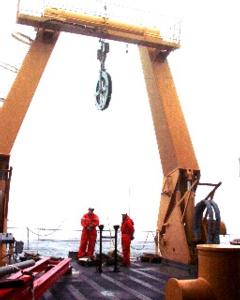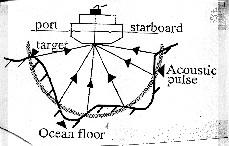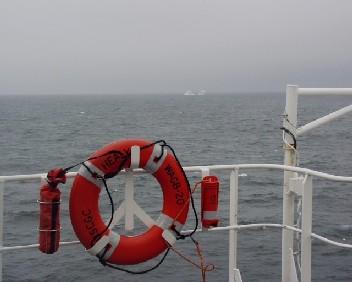29 May, 2000
Rock Ďní Roll Revival
May 29, 2000
Monday
Last night I was awakened by a loud KABOOM! in the middle of the night. I
bolted out of bed. "Susan! What was that noise?"
KABOOM! There it was again!
Susan rolled over in her rack (bed). "Oh, thatís just the waves crashing
against the bow. Itís nothing. Go back to sleep."
Susan has a lot more experience on ships than I do, since she spent a month
aboard the research vessel icebreaker Nathaniel Palmer in Antarctica last
year. Ship noises donít surprise her anymore. She rolled over and went back
to sleep. I got back in my rack, but I couldnít sleep. I lay there listening
to all the sounds on the ship. Waves crashed against the bow. The metal
drawers in our desk slid open and banged shut each time the ship rolled from
side to side. I felt like I was riding a horse that was galloping back to
the barn!
Pitch and roll make life on a ship interesting. They also create challenges
for scientists when they try to do their work. For example, imagine trying
to make a map of the ocean bottom from a ship. The sensors for the bottom
mapping sonar system on the Healy are mounted on
the underside of the ship. The sensors make a pinging sound that travels to
the bottom of the ocean and then bounces back to the ship like an echo. The
sensors record how long it takes each ďpingĒ to make the trip down and back.
The further away the bottom is, the longer the trip takes. In shallow water,
the trip is shorter. A computer records the data in the form of a three
dimensional topographic map that shows where the underwater mountains,
hills, and plains are located.
The problem is that every time the Healy rolls to the side, the sensors
move, too. That means that the ďpingĒ isnít always aimed straight down
towards the bottom of the ocean. Depending on the pitch (the movement of the
ship as it tips forward and back over the waves), and the roll (the movement
of the ship from side to side), the sensors might be pointing in a different
direction every few seconds.
Thatís why scientists use a special instrument called a vertical referencing
system. To understand how this instrument works, try this. Take a long piece
of string and attach some weights to one end. You can use washers if you
have them, but even a small rock will work. Now stand up and hold the other
end of the string in your hand so that the rock is just above the ground.
Hold as still as you can so that the string doesnít move. The weight of the
rock will pull the string straight down to the ground. The string is
perfectly vertical (straight up and down). You now have your own vertical
referencing system.
You can use this tool to tell if a picture on the wall is hung straight.
Just hold your string next to the side of the frame and compare. The string
will be vertical. Is the picture vertical, too, or is it crooked?
Sometimes this tool is called a plumb bob. The vertical referencing system
on the Healy is digital, but it works the same way. Just as the string tells
you if the picture is hanging crooked, this system tells the computer
whether the sensors on the bottom of the ship are pointing straight down or
if they are tilted to the side. Then the computer automatically adjusts the
data from the sensors. In that way, scientists solve the problem of pitch
and roll.
Now if only they could stop those desk drawers from banging, maybe I could
get a good nightís sleep!
To find out what an abyssal plain is, click on Susanís page:
Susanís Entry
Today.
DAILY DATA LOG (5/29/00):
Air Temperature: 2.2 degrees C / 36 degrees F
Latitude 51N
Longitude 50W
Sunrise 4:11 a.m.
Sunset 8:27 p.m.

This is the A-fram on the stern of the ship. Can you guess why they call it an A-frame?

You can see how the signals return to the ship.

This is the iceberg we saw today from the ship. It is pretty far off, but it looked big. Look in the middle of the picture on the horizon.
Contact the TEA in the field at
.
If you cannot connect through your browser, copy the
TEA's e-mail address in the "To:" line of
your favorite e-mail package.
|
